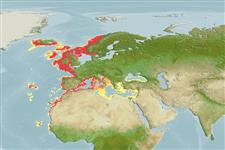Classification / Names
Common names from other countries
Issue
Raja macrorynchus Rafinesque, 1810 is considered as valid in Eschmeyer (Eschmeyer (CofF ver. Sep. 2011: Ref. 88002): Ref. 88002), although many authors put it in (questionable) synonymy with R. batis Linnaeus, 1758.
Main reference
Size / Weight / Age
Max length : 285 cm TL male/unsexed; (Ref. 35388); common length : 100.0 cm TL male/unsexed; (Ref. 3261); max. published weight: 97.1 kg (Ref. 40637)
Length at first maturity
Lm 160.0 range ? - ? cm
Environment
Marine; demersal; depth range 100 - 1000 m (Ref. 4426), usually 100 - 200 m (Ref. 4426)
Climate / Range
Subtropical, preferred 19°C (Ref. 107945); 69°N - 12°N, 30°W - 42°E
Distribution
Eastern Atlantic: Norway, Iceland, the Faroes to Senegal, including western Mediterranean and western part of the Baltic. Extirpated by trawling from much of its former range (Ref. 27438).
Countries | FAO areas | Ecosystems | Occurrences | Introductions
Short description
Dorsal
spines
(total): 0;
Anal
spines: 0;
Anal
soft rays: 0. Snout very long and pointed; length before eyes 2,5-4,0 times distance between them; disc broadly rhombic with acute outer corners; upper surface and underside smooth in young, partly prickly in larger specimens; no thorns on disc, a row of 12-18 thorns along tail; 40-56 tooth rows; upper surface olive-grey or brown with a variable pattern of light spots, underside ashy-grey to blue-grey (Ref. 3167).
IUCN Red List Status (Ref. 115185)
Threat to humans
Harmless
Human uses
Fisheries: minor commercial; gamefish: yes
More information
ReferencesAquacultureAquaculture profileStrainsGeneticsAllele frequenciesHeritabilityDiseasesProcessingMass conversion
Tools
Special reports
Download XML
Internet sources
Estimates of some properties based on models
Phylogenetic diversity index
PD50 = 0.5000 many relatives (e.g. carps) 0.5 - 2.0 few relatives (e.g. lungfishes)
Trophic Level
3.5 ±0.6 se; Based on diet studies.
Resilience
Very Low, minimum population doubling time more than 14 years (K=0.06; tm=11; tmax=51)
Vulnerability
Very high vulnerability (86 of 100)
Price category
